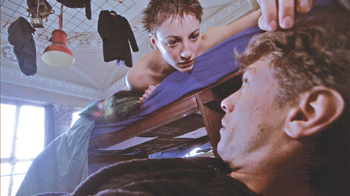![[Metroactive Movies]](/movies/gifs/movies468.gif)
[ Movies Index | Show Times | Silicon Valley | Metroactive Home | Archives ]

Photograph by Jerome Prebois Cine Comrades: Francesca Inaudi stares down Giorgio Pasotti. Savoy Trifle A guy, a girl, a gun and a camera love the movies not wisely but too well in 'After Midnight' "IS THERE too much suffering in the world?" musician John Cage asked his Zen instructor. "No, there is just the right amount." After Midnight (a.k.a. Dopo Mezzanotte) argues that the equation of suffering is always balanced. Since one person's unhappiness is balanced with another's happiness, the sum never changes. Director Davide Ferrario's film takes place in the ancient capital of Savoy: Turin, one of Italy's most chilly and hazardous cities, akin in some ways to Detroit. Amanda (Francesca Inaudi) has sheared black hair, a boxer's nose, a twisted mouth; she looks like a female David Thewlis. She's the "official but not only" girlfriend of the euphemistically named Angel (Fabio Troiano), a car thief from the ghetto of Falchera. The third party in the triangle is silent, dreamy Martino (Giorgio Pasotti), who watches his city from the bulbous tower of the city's architectural wonder, the Mole Antonelliana. The movie is essentially about the Mole. The omniscient narrator reminds us that audiences for antique cinema were often satisfied to see a film of a piece of noted architecture—a grand plaza or a monument. The hallucinatory Mole is, so to speak, a museum of hallucinations. It is the home of the national film museum of Italy. While Martino tends the place as a night watchman, he has his pleasure with the collection, the zoetropes, the nickelodeons and the magic lanterns. He always carries with him his vintage 9.5 mm crank-operated movie camera. Amanda's latest McJob blows over after she assaults her manager with a trough of hot french-fry tallow. Rescued by Martino, she hides with him in his tower of wonders while trying to decide what to do about the criminal she loves. After Midnight is dedicated to Buster Keaton. Punched by Angel, Martino does a perfect pratfall—the "Buster" that gave Keaton his stage name. The film ends with a re-creation of the iris-out shot in 1916's The Tramp. (The original of this famous Charlie Chaplin scene was shot on a dirt road near the town of Niles.) In those years before studio sets kept the real world away, whenever the silent camera went outdoors, it was inherently neorealist. There is neorealism in hard-bitten Amanda's jobs as payroll-advance-flier distributor, a gas-station cashier. But it's nearly impossible for an artist to forget everything he knows, and Ferrario changes the channel from tragedy to Jules and Jim. Angel turns out to be civilized, despite his overt toughness. The narrator makes his point about the perfection of cinema. Like the Fibonacci numbers—the famous mathematical sequence in red neon ornaments on the side of the Mole—Ferrari suggests that cinema gives the world's chaos some order. Well, this postmodern exercise is warmer than similar efforts to rephrase cinema—to reboot it—as in Lars von Trier's films. Still, as perfectly as this argument is shaped, there's a lack of spontaneity here. Intelligent and charming as this is, After Midnight is almost rigid with cleverness.
After Midnight (Unrated; 89 min.), directed and written by Davide Ferrario and starring Giorgio Pasotti and Francesca Inaudi, opens Fri at Camera 12 in downtown San Jose.
Send a letter to the editor about this story to letters@metronews.com. [ Silicon Valley | Metroactive Home | Archives ]
|
From the March 23-29, 2005 issue of Metro, Silicon Valley's Weekly Newspaper.
Copyright © Metro Publishing Inc. Metroactive is affiliated with the Boulevards Network.
For more information about the San Jose/Silicon Valley area, visit sanjose.com.